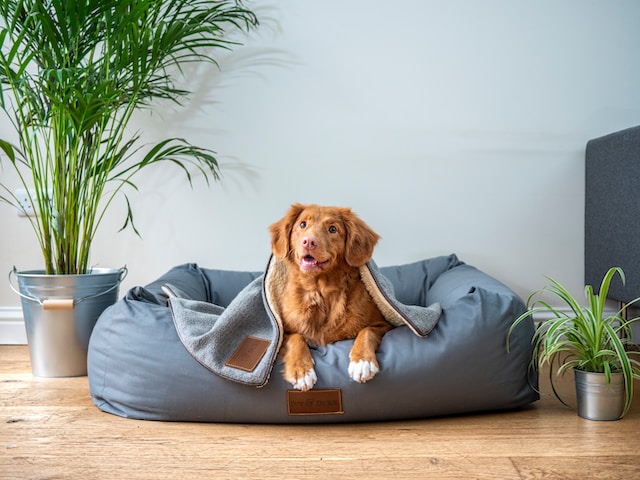Dogs are wonderful pets, but they can also leave behind quite a mess in our homes. From shedding fur to muddy paw prints, it can be challenging to keep your home clean and fresh when you have a dog. However, with a little bit of effort and some smart cleaning techniques, you can maintain a tidy and pleasant living environment for both you and your furry friend. Here are some tips on how to keep your home clean and fresh when you have a dog.
Groom your dog regularly
Keeping your home clean when you have a dog can be a challenge, but regular grooming can make a significant difference. Brushing your dog’s coat regularly can help to remove loose hair, dirt, and debris, preventing it from ending up on your floors and furniture. Grooming also helps to prevent matting and tangles, which can be uncomfortable for your dog. In addition to brushing, bathing your dog once a month (or as needed) can help to keep them smelling fresh and clean, and reduce the amount of dirt they bring into your home. Regular grooming not only helps to keep your home cleaner but also promotes good health and hygiene for your furry friend.
Vacuum and sweep regularly
As much as we love our furry companions, it’s no secret that dogs can leave behind a lot of hair and dirt in our homes. To keep your home clean and free from pet-related messes, it’s important to vacuum and sweep frequently. Invest in a high-quality vacuum cleaner that is designed to pick up pet hair, and make sure to give extra attention to areas where your dog spends the most time. This may include their bed, favorite spot on the couch, or the area around their food and water bowls. Additionally, sweeping floors and wiping down surfaces with a damp cloth can help to remove any dirt and debris that may have been tracked in on your dog’s paws. By keeping up with these cleaning tasks, you can help to maintain a clean and comfortable home for both you and your furry friend.
Use air purifiers
If you have a dog, an air purifier can be a great investment to help keep the air in your home clean and fresh. Pet dander, hair, and odors can all contribute to poor air quality, which can be especially problematic for people with allergies or respiratory issues. Look for air purifiers that are designed specifically for pets, as they often include HEPA filters and other features that are effective at capturing pet-related pollutants. These types of purifiers can help to remove pet hair, dander, and other allergens from the air, making it easier for you and your family to breathe comfortably. With an air purifier in your home, you can enjoy a cleaner, healthier environment for you and your furry friend.
Wash your dog’s bedding regularly
Regular washing of your dog’s bedding is important not only for maintaining a clean and pleasant smelling living space but also for preventing the buildup of harmful bacteria that can pose a threat to your dog’s health. Bacteria and odors can accumulate on your dog’s bedding over time, leading to skin irritation, respiratory issues, and other health problems. Washing your dog’s bedding with a high-quality pet-safe detergent at least once a week can help prevent the buildup of harmful bacteria and odors, ensuring that your dog has a safe and healthy sleeping environment. Additionally, frequent washing of your dog’s bedding can also reduce the risk of flea infestations and other parasitic infections.
Clean up accidents promptly
Accidents are an inevitable part of having a dog, and when they happen, it’s crucial to clean them up promptly to prevent stains and odors from setting in. Using a pet-safe cleaner that is designed to effectively remove pet stains and odors can help ensure that your home stays clean and fresh-smelling. When cleaning up a mess, it’s important to blot the area dry with a clean towel, rather than rubbing or scrubbing it, as this can spread the mess and make it more difficult to remove. Taking care to promptly clean up any accidents can help keep your home clean and odor-free, while also promoting good hygiene and preventing the spread of bacteria and germs.
Use odor neutralizers
In addition to using odor neutralizers, keeping your home well-ventilated can also help reduce pet odors. Open windows or use air purifiers to circulate fresh air throughout your home. Additionally, regularly washing your dog’s bedding, toys, and other items they come in contact with can help reduce odors. Finally, make sure to groom your dog regularly to prevent excess shedding, which can contribute to unpleasant odors. By taking these steps, you can help keep your home smelling fresh and clean, even with a furry friend around.
Train your dog
In addition to preventing messes, training your dog can also improve their behavior and strengthen the bond between you and your furry friend. Teach your dog basic commands, such as sit, stay, come, and leave it, to help them understand what is expected of them. Reward good behavior with treats and positive reinforcement. It’s important to be patient and consistent with your training efforts, as it may take time for your dog to learn new behaviors. Consider enrolling your dog in obedience classes to receive guidance from a professional trainer and socialize with other dogs.
Conclusion
In conclusion, keeping your home clean and fresh when you have a dog requires some effort, but it’s definitely achievable. By grooming your dog regularly, vacuuming and sweeping frequently, using air purifiers, washing your dog’s bedding, cleaning up accidents promptly, using odor neutralizers, and training your dog, you can maintain a clean and pleasant living environment for you and your furry friend.
